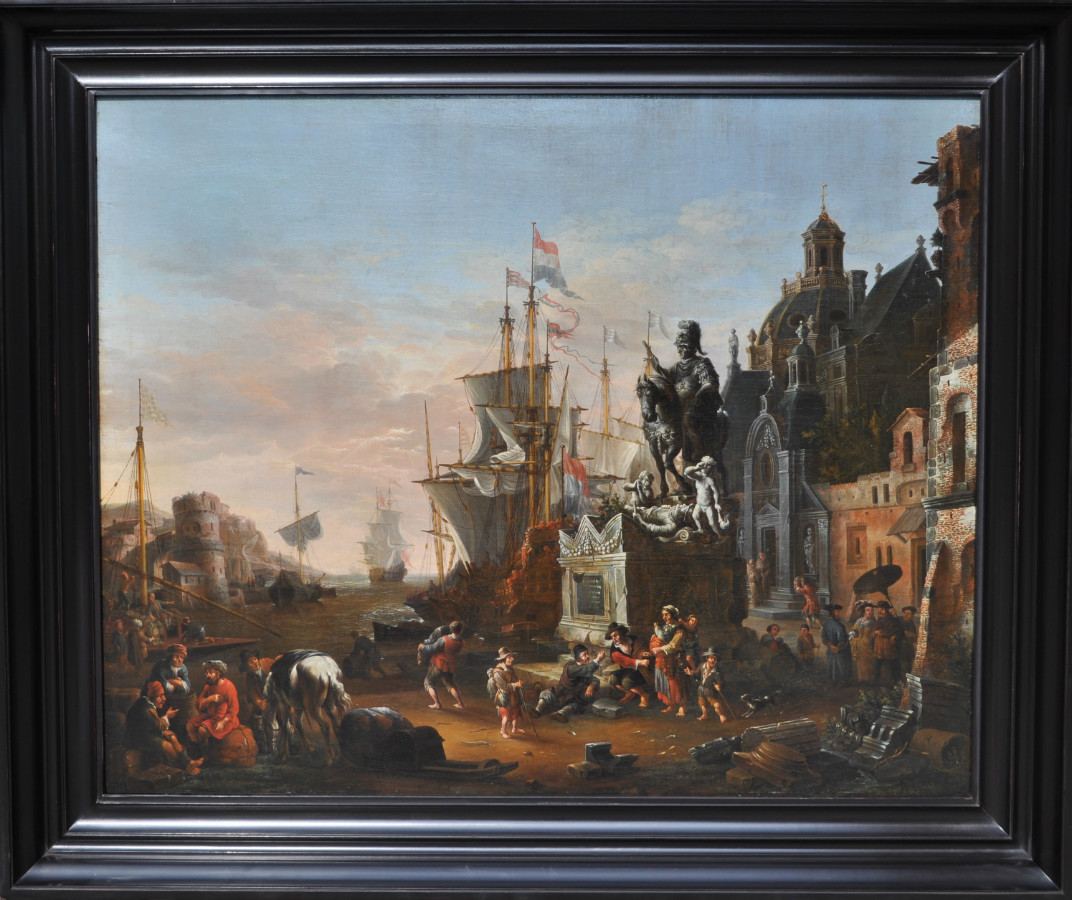Oil on canvas : 82,8 X 101,5 cm
Unsigned
Frame : 99,8 X 119,6 cm
I would like to thank Madam Marijke de Kinkelder from the RKD, The Hague, who has confirmed the attribution
"All paintings are fully documented with texts and photographs of comparative items. All this information is removed from our website once the painting is sold".

About Pieter van Mase
Dutch painter
Circa 1650 – 1703/1723
Active in Rotterdam during the second half of the 17th century. He was last mentioned in 1703 (valuing an estate in The Hague).
Dated works known between 1671 and 1703.
His last name is sometimes spelt van Maas, Maasis, Maes or Maesis.
Although working at a time were painting got more and more specialised, with painters active in just one or maybe two different domains, van Mase seems to have been marvellously old fashioned. He did not restrain himself to just painting the same subject(s) for the rest of his life. Van Mase painted a very diverse range of subjects at a very descent level of quality.
In a market where names can be more important than the sheer quality of painting it is not surprising that his paintings over the past years turned out to have been attributed to several well and better known contemporary painters.
He painted :
- Italianate and Levantine harbour scenes, related to Johannes Lingelbach (1622 – 1674), to Thomas Wijck (1616/24 – 1677), to Jan Baptist Weenix (1621 – 1663) and to Hendrick van Minderhout (1632 – 1696).
- Rhine river views, related to Herman Saftleven II (1609 – 1685).
- Italianate market scenes, related to Hendrick Mommers (circa 1623 – 1693).
- Dutch summer village feasts and winter views with ice skaters, reminding of Claes Molenaer and of Thomas Heeremans (1641 – 1697).
- Dutch beach scenes, reminding of Jan van Goyen (1596 – 1656) and of Claes Molenaer (before 1630 – 1676).
- Fish still lifes, like Abraham van Beyeren (1620/21 – 1690) and Isaac van Duynen (1628 – 1679/81).
- Birds and chickens in park landscapes, typical of Melchior de Hondecoeter (1636 – 1695).
Pieter van Mase was also active as staffage painter, including figures in paintings from colleagues. We know for example of two paintings by Jan Sonjé holding numerous figures by van Mase : one is in Ouwater, in the old catholic rectory, the other one we sold in 2006 (the pool of Bethesda).
Jan Gabrielsz. Sonjé was a Dutch landscape painter (Delft circa 1625 – 1707 Rotterdam?), a pupil of Adam Pynacker. Sonjé left Delft in 1654, probably after the huge explosion of its powder-magazine, for Rotterdam. In 1678, 1686 and 1692 he was Dean of the Guild of Saint Luke in Rotterdam. In 1668 he lived in Dordrecht.
Pieter’s brother, Gerrit, was also active as painter in Rotterdam.
About our painting
We are thankful to Madam Marijke de Kinkelder, curator of Old Master Paintings at the Netherlands Institute for Art History (RKD) in The Hague.
She is preparing an article on van Mase and procured us with her ample documentation on the painter. She also fully confirmed the attribution to van Mase of our painting.
Pieter van Mase regularly signed his paintings as “PV Mase”, “PV Maasis”, “PV Maasius” and as “PV Maes”. Our painting is not signed, but it bears a confusing monogram and date “PW 1656” in the middle bottom, on the piece of luggage carried on a sledge, drawn by the white horse. According to Madam de Kinkelder these do not refer to the painter, but to the luggage (as so often in these kind of harbour views), and thus possibly to the commissioner of the painting.
Van Mase’s Mediterranean harbour views rank amongst his best, most elaborate and richly detailed paintings. Some characteristics and elements in our painting can be found back in other complex compositions by Pieter van Mase :
- a monumental sculpture dominating a square
- the use of a repousseoir at either end
- men sitting and conversing on the ground
- the detailed rendering of brickwork
- the squareness of the faces of the figures
- a rich couple strolling, protected by an exotic (Indonesian?) umbrella
Why should you buy this painting?
Because it is such a rich composition, a sheer visual bombardment: from resting stevedores in an Italianate harbour with a Claude le Lorrain-like sundown, over a magnificent sailing ship and a huge dramatic monument with resting beggars, to a church building reminding of the cathedral of Aachen and rich people strolling under an exotic parasol.
